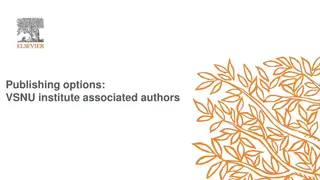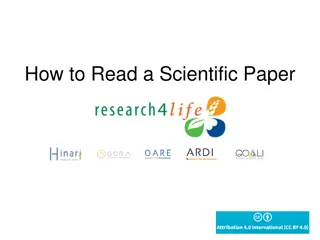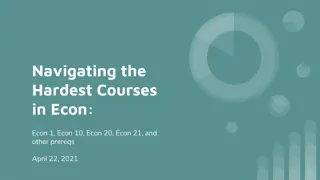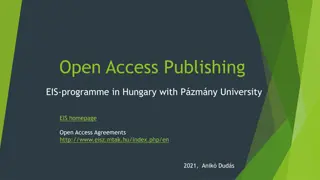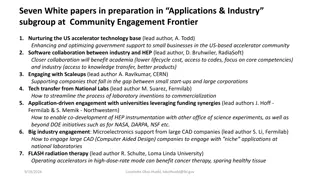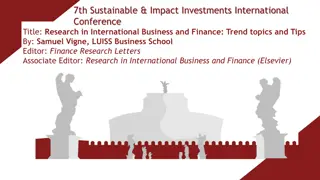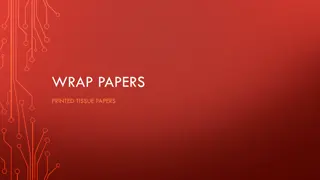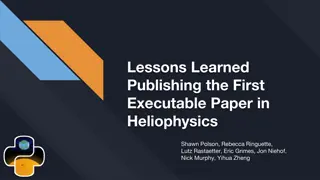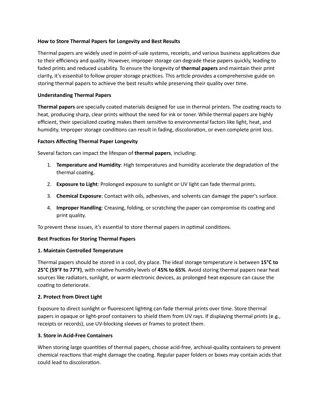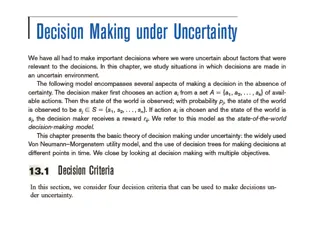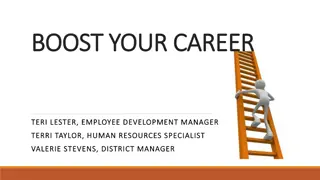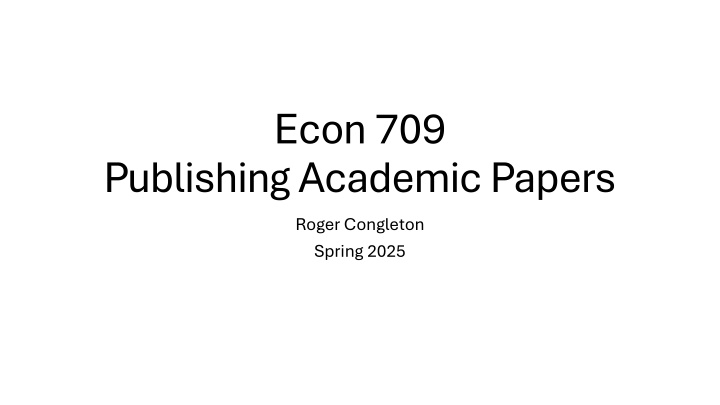
Academic Paper Publication: Strategies and Tips for Success
Learn valuable insights on choosing a research topic, selecting the right journal for publication, understanding reviewers' expectations, and aiming for a successful revise and resubmit process. Enhance your academic paper publishing skills with expert guidance.
Download Presentation

Please find below an Image/Link to download the presentation.
The content on the website is provided AS IS for your information and personal use only. It may not be sold, licensed, or shared on other websites without obtaining consent from the author. If you encounter any issues during the download, it is possible that the publisher has removed the file from their server.
You are allowed to download the files provided on this website for personal or commercial use, subject to the condition that they are used lawfully. All files are the property of their respective owners.
The content on the website is provided AS IS for your information and personal use only. It may not be sold, licensed, or shared on other websites without obtaining consent from the author.
E N D
Presentation Transcript
Econ 709 Publishing Academic Papers Roger Congleton Spring 2025
Choosing a Topic The aim of a research paper is to fill a gap in the knowledge in some field. So, the first thing to consider is whether an idea or paper that you have will do so. Is it new based on the readings that you ve done in class or seminars that you ve heard at WVU? Is it extending an existing piece by improving a model? Using new and better data? Using newer and better econometric methods? A completely new idea? As you go through your career, newness will be determined by your readings in journals, papers heard at conferences and seminars, conversations with other economists, and your colleagues. But in the beginning, it will be based on your classes at WVU, the seminar that you ve attended, and conversations with faculty and your fellow students, as well as your own reading. There are a surprising number of gaps in the literature, even today after tens of thousands of published papers and a century and a half of neoclassical research.
Where to publish? Where to publish a paper, of course, depends on the paper. If you are significantly extending a paper that is already published, you might try the original journal in which that piece was published if yours is a reasonably significant extension of it. If it is a minor extension, look for a lesser journal that publishes the same sort of papers. Editors all have preferences, and reveal them through the papers that they send out for review, and thereby in the papers that a journal publishes. (You cannot change an editor or the standards used by the editor and his/her reviewers. They are givens. ) To find journals that publish similar material, written at a similar level, do not look for the weakest paper ever published in a journal but the average or median paper. To do so, peruse the abstracts of the past year or two of papers published in journals that you think might be interested in your work. If your methods and writing are in that ballpark then your paper will have a good chance at the journal that you ve found.
Who are the reviewers? Reviewers are mostly volunteers who work for free. They are busy men and woman. Usually smart and often, but not always, diligent. They are often, but not always, selected from among the persons cited in your paper or persons that have published on the same topic in the journal that you ve submitted to. They are usually busy scholars with their own research agendas (and very much like to be cited). They will spend at most a couple of hours working through your paper more often a half hour or so. To please them, the writing should be clear and sophisticated as should the work. It should be respectful of other work in the field and show a reasonably complete understanding of it (through its concise review of the literature in the section just after its introduction). Even if you think another piece it totally wrong, do not say that. He/she/they may be your reviewer. The just neglected some point of interest.
The Goal is an R&Ran invitation to revise and resubmit your paper No matter how hard you work and how much care you have invested in your paper, it will never be accepted as written. But that does not mean that you should not do your best with your paper before sending it off. should not do your best with your paper before sending it off. This is partly because even good and generous reviewers can always think of a few ways that a paper can be improved. Not all reviewers are good or generous, and many are inclined to be a bit nasty. That is just life. If you get an R&R give every suggestion serious attention and try to accommodate them even if you think that their suggestions are a bit wrong headed. (Remember the reviewer is rarely open to argument.) Also busy editors tend to defer to their reviewers often expecting unanimous agreement as a prerequisite for publication. This is especially true of the most prestigious journals (A and A+ journals). So, do your best to please the referees by doing most of what they suggest. But that does not mean that you
Rejectionswhat to do next There are two kinds of rejections two kinds of rejections. Ones with comments and ones without. If you receive a desk reject without comments without comments, it means that you ve misjudged the journal that you submitted to it either does not publish papers along the lines of yours for whatever reason. In that case, the next step is to do a bit more homework on journals (The Australian Business Deans list of journals is a good place to start looking for the next place to submit it.) If you receive a desk rejection with comments with comments. First read the editor s letter is he/she actually giving you advice about how to fix your paper so that he might send it off to referees if you incorporate his/her suggestions. (this is a rejection and resubmit rejection and resubmit letter). If not, think about the next place to send it. If your paper received negative reviews from one or more referees, take a look at them and see if they are making worthwhile suggestions. Some referees are generous with suggestions even when they reject a paper. If there are any worthwhile ones, follow them up. Otherwise, just go on to the next journal that you think might be interested in the paper. Normally this process involves going to lesser journals but occasionally the suggestions are good enough that you might consider going up a level after undertaking them. Don t do that unless you are a risk taker or already have some good publications if you are trying to earn tenure. Very occasionally, you can write the editor and try to persuade him/her that one of the reviewers misunderstood your paper even though your writing and work was very clearly explained. (this rarely works in my experience, but sometimes it does. (EJ story, JMCB story same referee)
Diversify If you get a tenure track job or want one, it is a good idea to diversify. That is to say, write two or three papers and submit them to journals. It is not too hard to write two or three papers a year if you work consistently at it but impossible if you do not spend a lot of time at the keyboard, unless you have a magic pen. When I started out, I would try to have three papers under review at a time with one at a high , one at a medium, and oneat a low journal, with the expectation that one of the papers would hit (get an R&R or acceptance), or would in the near future (e.g. at the next journal). There are a few annoying people that always have success but its very rare and I know lots of prolific publishers that get rejected repeatedly. Since your draw of referees is somewhat random but do read editor and referee suggestions, and try to incorporate the suggestions that seem reasonable and are not too hard to incorporate into your paper. Diversification is the best way of reducing the risk of not publishing writing perfect papers. (Keep in mind that even Nobel Prize winners have their papers rejected their papers rejected, if not quite as frequently as you are likely to when you are just starting out.) random, the model is try try again, risk of not publishing, short of even Nobel Prize winners have
Publishing for Tenure Most universities and colleges even teaching-oriented ones expect you to publish at least a couple of papers. The publication thresholds for tenure vary quite a bit. At research-oriented schools, the targets are surprisingly similar, more or less one good publication or so per year, with the definition of good varying a bit. Most people who get tenure at WVU have between 6 and 10 papers after six years, and a mix of A and B and C papers with at least 2 or 3 A-journal hits. One common strategy is to link up with one or two of your professors for a couple of papers, and write with them as second author. This is a useful way to learn the trade to see what a finished paper looks like and how to deal with rejections. It is not necessary, just a common method. You may think that you are doing your prof a professor by doing so, but in most cases, it is he/she who is doing you a favor. (JMB story)
Finding an Editor that Likes Your Work After a two or three years of publishing papers, you may find that a particular journal is more likely to publish your papers than others. When that happens, continue sending your papers there. If it is an A journal for your department (or ours) just keep sending your papers there. Not all will hit, but your probability of success will be higher. If it s a lower journal (a B or a C), continue with the diversification strategy, but use them for one of your 3 base-hit papers each year. This is not cheating it is simply taking advantage of editorial preferences which they all have. It is not the same thing as using connections or coauthoring with a person that does. (Some journals have very tight networks and in those cases to break in, you may well need to coauthor with someone who is a member of the network of interest. I would not worry about that at this point in your career.) In general, publishing academic takes a bit of luck and lots of persistence. Good Luck.



